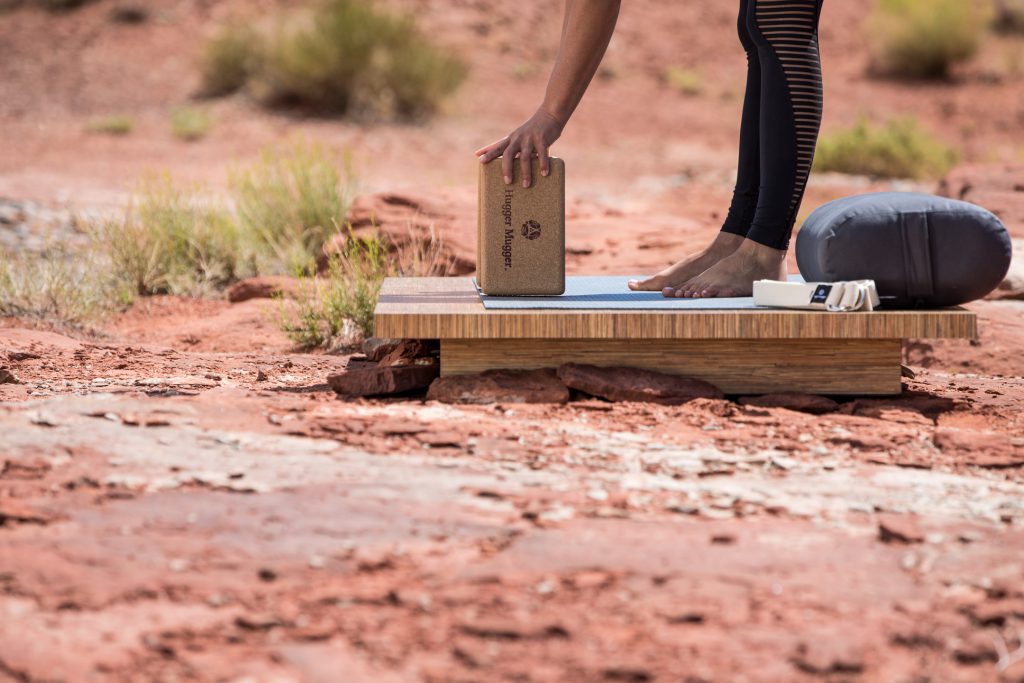
Some say there are two generations of yoga: one before the widespread use of yoga props, and and one after.
Before props hit the mainstream, yoga was less about perfecting asana and instead focused heavily on the spiritual and communal aspects of yoga. Then, therapeutic and restorative yoga became more popular and Iyengar invented some wooden benches, chairs, bungees, and ropes for people with restrictions. Suddenly, yogis everywhere found themselves sinking deep into that juicy pose with the help of a prop.
But props weren’t always so widely welcomed.
It was as if people were ashamed of them when they were first introduced in the 1970’s. This was probably because teachers would only give them to students who couldn’t do certain poses. Overall, yogis tried to use as few props as possible.
Now that we have props available, the practice has become more about the meditation or spirituality alone. People are into pushing their bodies physically. Yoga has become as much as a fitness craze as Pilates or CrossFit.
And the ego continues to rise to the occasion.
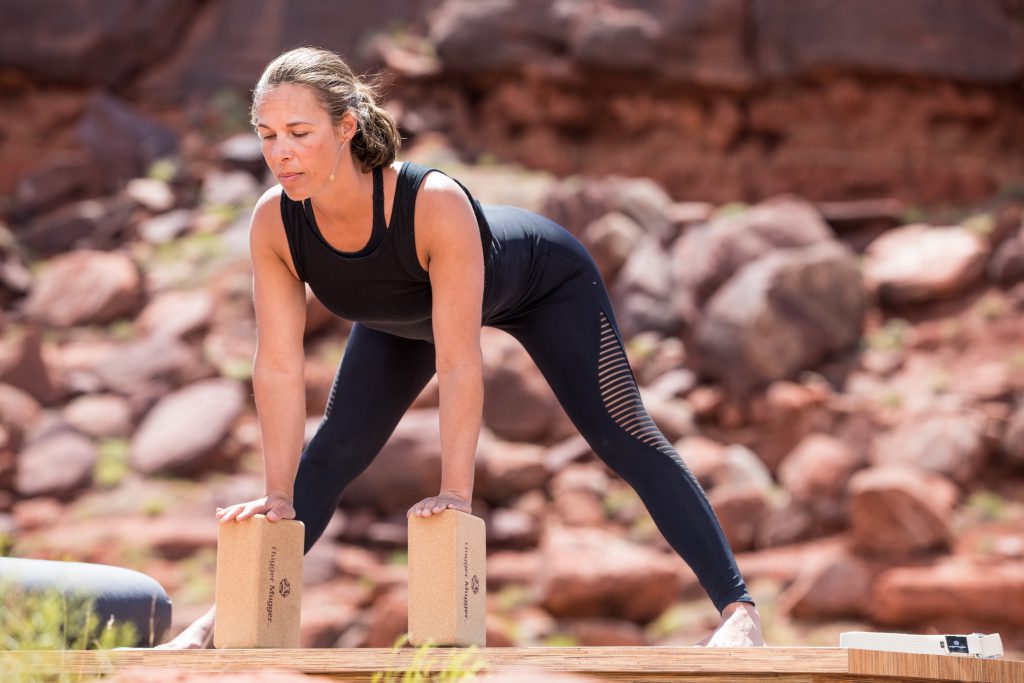
Yoga blocks are saviors for tight hamstrings.
Drop Your Ego, Grab a Yoga Prop
Today, it’s common to walk into a yoga class and the teacher says, “grab two blocks and a strap” or perhaps “a blanket, bolster, and chair.”
But still, some would rather sacrifice the benefits of the asana for the ego, sometimes dangerously pushing the body, to prove to themselves or others that they can do the pose without props.
But the ego is fooling them. They aren’t getting the full benefits from the pose, or even really doing the pose, if their alignment is all wrong.
Let’s face it, we all have restrictions.
Props give all yogis the opportunity to reap the same amazing benefits that were previously only available to those who mastered the most advanced asanas. At the same time, the yoga props are training the mind and body so we can get there someday.
Don’t let the ego push the body around, and never skip out on the benefits of the asanas for the sake of the ego. Even if you’re strong, flexible, uninjured, or advanced in your yoga practice, you may still benefit from a little extra help or support. Overcoming your ego means learning to be OK with that!
Even when you finally “perfect” a pose without the help of a prop, another door opens to new world filled with advanced versions of that pose, related asanas and binds. So it’s never ending, really. There’s always more to learn. That’s what props are here for; they’re learning tools.
Becoming more and more interested in proper physical alignment a natural step in the yogic journey; it’s a good thing, and here’s why. Think of how many times in a day you find your shoulders scrunched up by your ears. You adjust your shoulder blades back down your back. Ahh, relief. Then, a few hours later stress has welcomed them back up by your ears, again, ouch!
Eventually, if you practice enough, you won’t have to remind yourself to put your shoulders where they belong so often. The alignment will become more natural.
The same is true in yoga.
Sometimes your body might feel like two entirely different bodies, right side to left side. Whether it’s because of a natural dominant side, injuries, or simply bad habits, you will probably feel major differences from one side of your body to the other.
But the two sides of our bodies don’t have to be so different. Just because they might be today doesn’t mean that we can’t work towards balance tomorrow. Yoga props can help bring the body back into balance.
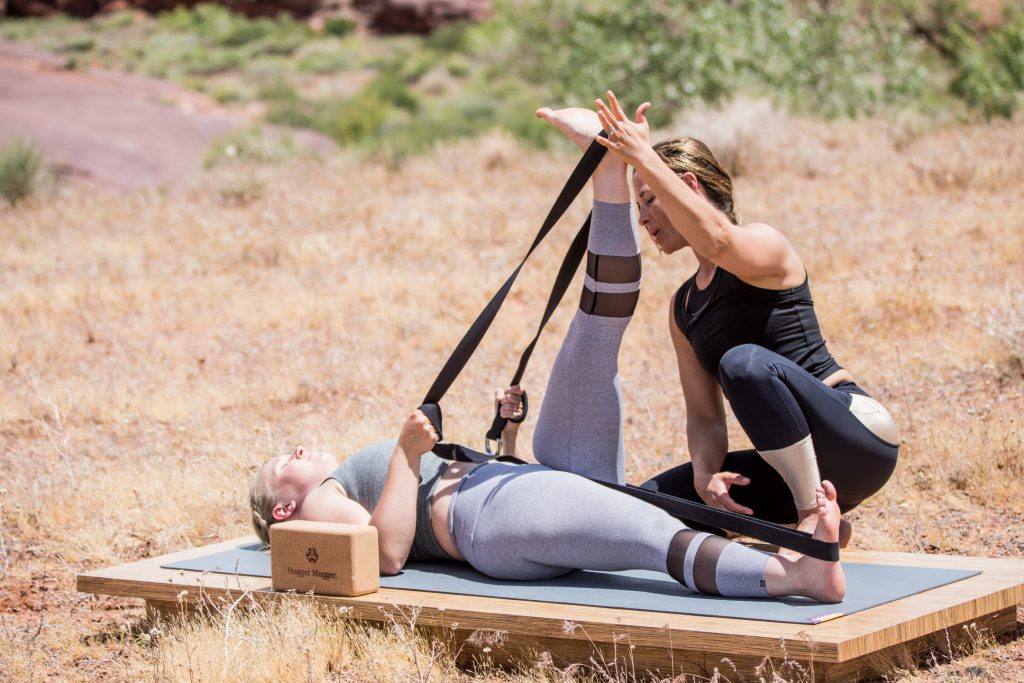
Sometimes two is better than one! The use of yoga straps in supta padangustasana can help reset an unbalanced sacrum.
But Props Are A Crutch!
That may be your ego talking again. You brought your mat with you, didn’t you? That’s a prop — the most common one we use in the yoga studio, in fact. Why do you use a sticky mat? Probably so your feet and hands don’t slip and you can find stability, comfort and stillness. Simple. So, why stop there?
Whoever decided that yoga props are embarrassing and only for those with restrictions is blindly denying the fact that we all start somewhere.
Yes, props do help yogis into asanas that they can’t yet do without help. But the key word is yet. When using props in your yoga practice, you deserve major kudos because you’re working towards performing the asana in proper form and not risking tearing a muscle to impress a yoga teacher or fellow yogi! Now that, my friend, sounds much more embarrassing than resting on a block or two in pigeon pose.
Yoga props can be restorative, too. We’re human — we all get stressed. Our bodies respond to this. You may find that there is nothing better than lying in supported fish pose with a two blocks under your back when it feels tight after a long day or a night of tossing and turning. Props help us find even more depth and comfort in the poses we’re already comfortable in so we can focus on what’s really important: being present and turning inward.
I’m sure you’ve heard a yoga teacher somewhere say something like, “Progress is a journey. It is not a competition. Where you are is where you are right now. There is no right or wrong.”
This isn’t just inspirational mumbo jumbo, though. There really is no right or wrong in the yoga room. Our bodies are all unique and can feel different from one day to the next. The point of practicing yoga is not to look good to others or to stroke the ego. We are supposed to learn the poses and reap the benefits while enjoying the process of endless progression.
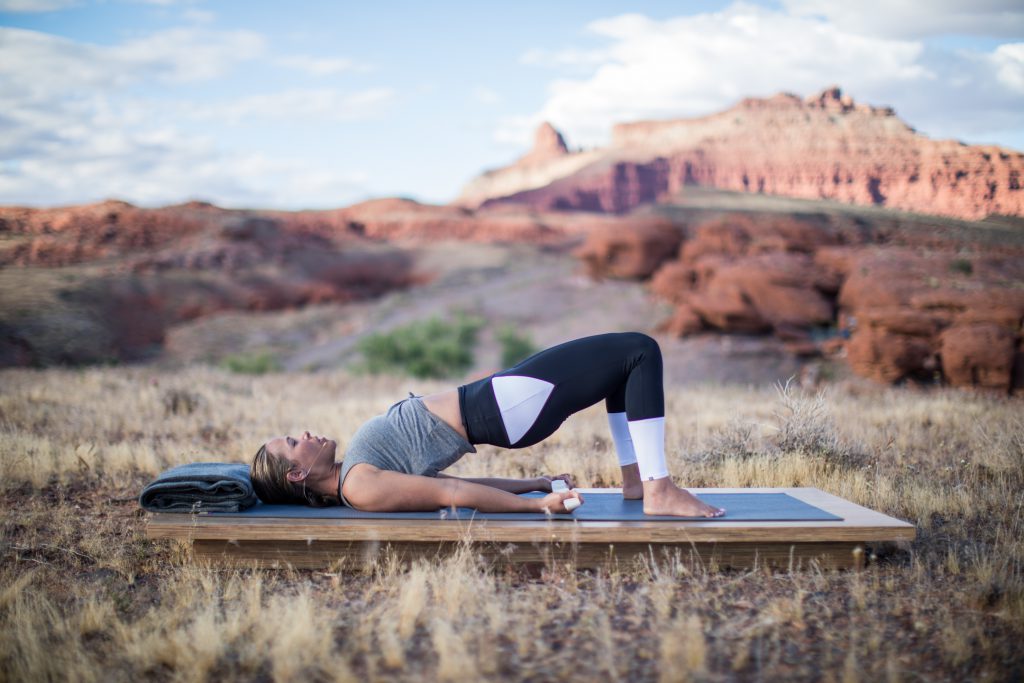
Yoga straps can help train the shoulders and chest for more advanced backbending.
Instagram makes it easy to share progress with world. Side by side, two pictures of the same pose invoke a “before” and “after” effect that leaves the world forgetting about what’s in between: the process.
A picture of a beautiful pose doesn’t reflect a beautiful practice. A beautiful practice is made up of the journey the yogi has taken to arrive in the asana on their mat. Many flexible people can strike an impressive pose, but are their hips aligned correctly? Are their quadriceps engaged? Did they remember to breathe?
In the mean time, don’t push it! Let props help you learn alignment in new asanas so you can eventually remove the props and take that beautiful photo.
There is no end-game in yoga — we have the endless opportunity to improve. One day, or one year, or however long it takes, when we finally achieve that previously impossible pose, we can rejoice, remember how far we’ve come, and then get back to work.
Hugger Mugger Your Ego
Hugger Mugger is an established, innovative yoga company that has been making quality yoga props and clothing since 1986. You may recognize Hugger Mugger mats, blocks, straps, and more from on our our online yoga classes on YogaToday.
What is a “hugger mugger” anyway? What does it mean? (Maybe you’ve wondered this while finding stillness in savasana.)
Hugger mugger literally means “to conceal.” It’s a very old term often used in Shakespeare plays.
Hugger Mugger found it roots when Sarah Chambers took a workshop with Mary Dunn, who needed a strap to show a modification for a pose. Another student in the room had a belt, which worked even better than the neckties that yogis were using at the time. The belt inspired Sarah, but she knew she could create something better.
One week later, she showed up to class with two inventions: a cotton strap with a D-ring and a pair of maroon velour gym shorts. The shorts had thigh-hugging elastic bands that kept the shorts in place during inversions and wide-legged poses. They hid what we don’t want to show to the yoga room.
Just like props, the shorts provide that one bit of comfort that eliminates distraction. With this distraction removed, the yogi can focus on the pose instead. Props help clean the process up a bit by providing comfort. It makes sense why someone would name a company that makes yoga props and clothing “hugger mugger.”
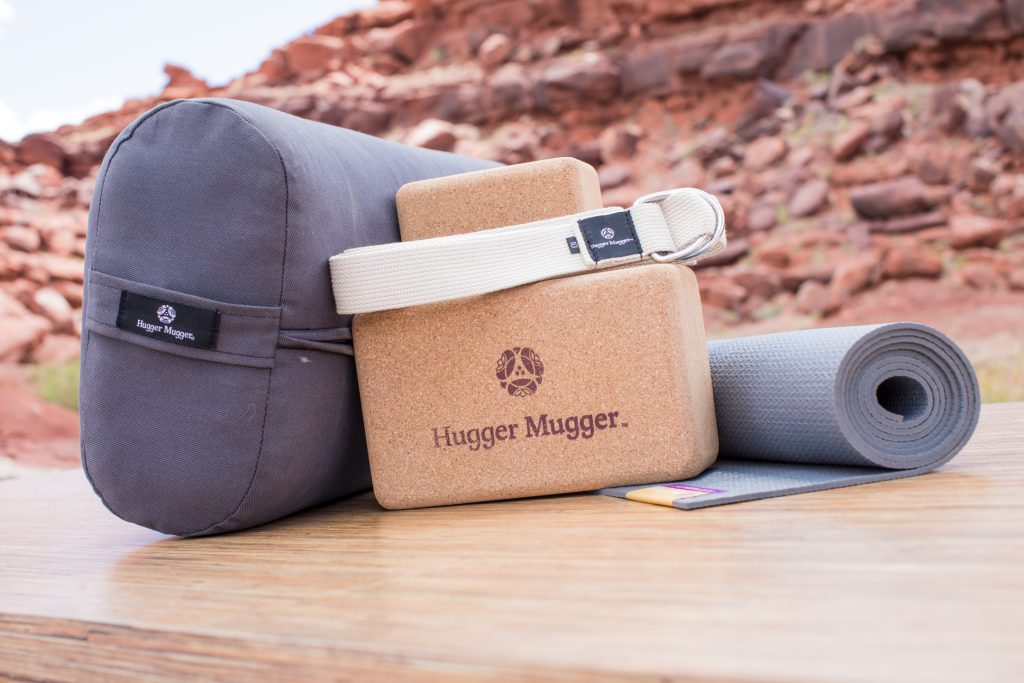
Today’s versions of original Hugger Mugger designs.
Props help conceal and maybe even silence the ego so we can accept where we are in our yoga journey. No one needs to know, or even cares, that you need help in an asana. The process is personal and really none of anyone else’s business except your own.
The props create a nurturing space to improve — to do the work.
Eventually you’ll remove the block or release the strap.
You’ll find the body and mind have learned how to do the asana without help.
Then get back to work.
About the Author
Jess Goucher is a snowboarder, yogi, food lover, and lacrosse coach living in Jackson Hole, Wyoming. When she’s not snowboarding, you’ll find her on the trails with her husky, Tao, or helping out with production at YogaToday.
